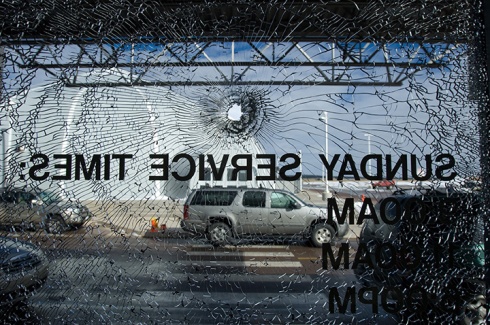
As many as twenty bullet holes riddle the entryway of the New Life church in Colorado Springs, Monday, Dec. 10, 2007, where a day earlier a gunman entered the building. Two are dead in addition to the gunman and another two are injured in the second shooting to hit a Colorado religious organization in a day. The gunman in the Colorado Springs shooting was killed by a church security guard. Two are dead in a possibly related shootings at a dormitory for missionaries in Arvada, Colo., a suburb of Denver. (Kevin Moloney for the New York Times)
Anyone who follows any news in the 21st-century mediascape has experienced this feral and uncoordinated form of transmedia journalism first hand.
Here in Colorado last month we suffered massive and destructive flooding. The story is still unfolding and the aftermath will endure for months more. When the news struck that local mountain streams would surpass 100-year flood levels, I, my friends and colleagues dove headlong into a diverse array of media forms and channels to digest the news. I turned on the local TV broadcasts, I listened actively to local public radio, I watched Twitter hashtags, Facebook posts, Instagram feeds, awaited SMS texts from the university and picked up the phone to talk to friends and relatives.
I didn’t get the story from one place — multiple devices and technologies of all ages were used. I didn’t get it in any one media form — the story came as text, video, audio, conversation and even in the clouds outside my window. I absorbed complete stories from multiple sources and sewed them into a larger and more complex picture of what was happening than I could of had I depended on only one of them.
This applies to other breaking stories, from the Navy Yard shootings to the Boston Marathon bombings to Sandy Hook Elementary. Once engaged with a story that demands fast attention, we immerse ourselves in multiple spaces in the mediascape — online and off — to gather the complete and current picture.
This is not a planned and curated form of transmedia journalism. It is a natural form created by each individual as he or she engages with the story. It illustrates the idea that we can engage with multiple characters across multiple stories in multiple places to achieve what game designer Neil Young calls “additive comprehension.”
We are deeply engaged when rapidly moving events raise cultural, civil or environmental concerns, or has an immediate impact on our lives. A drive to know more, see more and stay up-to-date leads us naturally to transmedial consumption of news. But what about the stories that don’t scream for immediate attention to any and every media form and channel available? Here, as we do for traditional news stories, we depend on style, human connection and compelling narratives to draw a public. We can carry those techniques to predesigned transmedia narratives so that, once engaged, the public has somewhere to find more. Through transmedia implementation we we also open many more access points for the public to find our story.

October 22nd, 2013 at 9:00 pm
Great comments, Kevin!
October 22nd, 2013 at 9:20 pm
When big news breaks, I turn to all forms of media while it’s breaking. However, I find a need to read the curated newspaper stories the next day to get the big picture. It tames the chaos of the breaking story.
October 22nd, 2013 at 9:29 pm
Thanks Laurie! The “designed” transmedia should begin at day 2, to complete context and impact and prognosis for a life-changing event.
October 23rd, 2013 at 1:04 pm
I now have the habit of “turning off” my receptors from any “news” that appears to be “late-breaking news!!!” DEADlines KILL real reporting.
October 23rd, 2013 at 12:58 pm
The multiplicity of media has significantly complicated, not simplified, normal business communications, not just the media. ere are marked differences between the generations regarding the preferred media, resulting in worse and worse communications across generational lines in the business world. This week I experienced for the first time a very large national company that revised it’s customer communication system such that it nolonger provides human contact AT ALL, for accepting payment, exept online using their virtual shopping cart! (Verizon). Such limitations will result in losses of market share, delays in both initiation and completion of communication and transactions, and a general economic slowdown that could make 2007-2011 look small by comparison. Add to this the virtually constant “upgrading” of equipment and operational systems by their respective manufacturers , …. and the fact that ALL one way messenging is actually SLOWER and less complete communication than F2F or even a phone call … This IS the “elephant in the room” …. Go gittum, Kevin! This is a HUGE series of interelated problems.
October 23rd, 2013 at 1:01 pm
Additional thought: South American and Southeast Asian cultures BOTH still value face-to-face and two way communication.Those regions may, as a result, economically surpass both Europe and North American economies by 2020.
October 23rd, 2013 at 8:31 pm
Not sure I have much to add. I had a bit of a weird experience collecting news about the flood. I was out of the country and got quite a bit of my news from Canadian public radio. In reality I just thought there should be someone without the name Moloney to comment on the story.
October 24th, 2013 at 12:03 am
😉 Yes, Jason, I have many smart, engaged and supportive cousins…
March 23rd, 2014 at 3:07 pm
[…] As many as twenty bullet holes riddle the entryway of the New Life church in Colorado Springs, Monday, Dec. 10, 2007, where a day earlier a gunman entered the building. […]
October 22nd, 2014 at 2:23 pm
[…] […]
November 2nd, 2014 at 4:45 am
[…] Anyone who follows any news in the 21st-century mediascape has experienced this native and uncoordinated form of transmedia journalism first hand. Here in Colorado last month we suffered massive an… […]
November 26th, 2018 at 10:53 pm
[…] Moloney, K. (2011-2018a). Breaking news as native transmedia journalism. Transmedia journalism. Recuperado el 15 de noviembre de 2018 de https://transmediajournalism.org/2013/10/22/breaking-news-as-native-transmedia-journalism/ […]
September 30th, 2022 at 6:55 am
[…] ‘story world’ were being distributed between films, animated shorts, comic books and games. But the same principle has been applied to news reporting where different information about a news event might be reported on Twitter, Facebook Live, radio […]